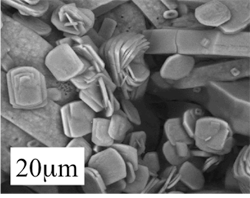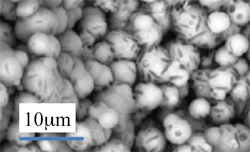BERKELEY, CA (UroToday.com) - Pathological calcifications are associated with major public health problems such as diabetes type II.[1,2]
Over the past several years, we have conducted translational research defined through a multi-scale description of their structural and chemical characteristics in order to:
- propose physical methods as diagnostic tools, [3]
- establish a relationship between their structural characteristics and medical management,[4]
or
- to describe the biochemical processes which lead to their pathogenesis[5]
This research program encompasses the investigation of pathological calcifications present in kidney,[6], prostate,[7] cartilage,[8] cardiac valves[9] and thyroid. It is crystal clear that synchrotron radiation (SR) related techniques play a key role in our research.[10, 11, 12, 13, 14,15] Indeed, the very first spectra collected on Soleil - synchrotron was collected on kidney stones (KS).[16]
Example of results:
Randall‘s plaque and synchrotron radiation investigation
We have investigated a calcified plaque named Randall 's Plaque (RP) deposited beneath the epithelium near the tip of renal papillae.[5] Such plaques act as an anchored nidus for calcium oxalate (CaOx) stones, which exhibit a concave region (Figure 1). A dramatic increase in the prevalence of kidney stones developed from a RP was observed in western countries. As we can see in Figure 2, in 2010, more than 55% of CaOx kidney stones display a RP at their surface in young stone formers aged 20 to 30 years versus 16% in the 1990s. We have characterized RP through X-ray absorption spectroscopy (XAS) at the Ca K edge. Such ex vivo configuration preserves the state of crystallization which depends on the hydration level.
Figure 1. CaOx monohydrate stone nucleated from a papillary RP (arrow)
Figure 2. Increase with time of the proportion of calcium oxalate stones nucleated from a RP
Through X-ray absorption spectroscopy, we demonstrated, for the first time, direct structural evidence of the significant presence of ACCP as a major constituent of RP [17]. Moreover, our measurements suggest that ACCP are deposited within the tissue, and not only at the surface of the papilla. From a biochemical point of view, it is worthwhile to underline that in kidney ACCP there is evidence of an oversaturation in Ca phosphate by an excess of Ca and/or phosphate and/or due to too high pH. Such chemical composition of RP, present in increasingly young subjects, raises a major question regarding alimentation: does nutrient-enriched food specially aimed at young children affect the physiology of the kidney?
Primary Hyperoxaluria and Scanning Electron Microscope as a diagnostic tool: a publication in New England J. of Medicine
Primary hyperoxaluria type 1 is a rare inherited disease leading to recurrent nephrolithiasis, nephrocalcinosis, systemic oxalosis, and renal failure, ultimately requiring combined kidney and liver transplantation.[18,19] Because of the rarity of this disorder, the diagnosis is often missed or delayed by several years, especially when the disease first manifests in adulthood, thus depriving patients of the benefits of therapeutic measures had they been instituted in a timely manner. Therefore, any method facilitating early diagnosis is eagerly sought.
Figure 3. Whewellite crystals related to primary hyperoxaluria
Scanning electron microscopy observation confirmed a crystalline structure in the primary hyperoxaluria type 1 stone that was distinct from that of the common type of whewellite stone. This unique morphologic characteristic and the ultrastructure of primary hyperoxaluria type 1 stones suggest a fundamental difference in the mechanism of stone formation, reflecting the very rapid and permanent crystal formation induced by genetic hyperoxaluria.
Relationships Between Carbonation Rate of Carbapatite and Morphologic Characteristics of Calcium Phosphate Stones and Etiology[20]
The objective was to examine the significance of the carbonation rate (CR) in carbonated apatite (carbapatite [CA]) stones and its relationships with the morphologic characteristics of CA and etiology. CA stones without struvite can result from metabolic disorders or urinary tract infection, but the latter etiology is still debated. Infection stones caused by urea-splitting bacteria are made of CA mixed with struvite and exhibit a high CO32-/PO43- ratio (CR). However, little is known as to the significance of the CR of CA in the absence of struvite in idiopathic calcium phosphate stones.
A close relationship was observed between the presence of bacterial imprints, indicative of past or current urinary tract infection, and both the presence of amorphous carbonated calcium phosphate (or whitlockite) and a high CR of CA.
Figure 4. Presence of bacterial imprints at the surface apatite crystallites
References
- Daudon M et al. 2012 Lithiase urinaire. 2d edition. Médecine-Sciences, Lavoisier, Paris.
- Bazin D, Combes Ch, Rey Ch, Daudon M 2012, Chem Rev.
- Daudon M, Junger P, Bazin D 2008 New England Journal of Medicine 359 100
- Daudon M, et al. 2009 J. Applied Crystallography 42 109
- Daudon M, Traxer O, Jungers P, Bazin D 2007 Renal Stone Disease 900 26
- Daudon M, Jungers P, Bazin D 2008 Renal Stone Disease II 1049 199
- Dessombz A et al. 2001 Progrès en Urologie 21 940
- Ea HK et al. 2011 Arthritis & Rheumatism 63 10
- Dorfmüller P et al. 2010, Cardiology Research and Practice 685926
- Bazin D et al. 2006 Annales de Biologie Clinique 64 125
- Bazin D, Chevallier P, Matzen G, Jungers P, Daudon M 2007 Urological Research 35 179
- Bazin D et al. 2009 Osteoporosis International 20 1065
- Bazin D et al. 2009 Biochimie 91 1294
- Nguyen Ch et al. 2011 J. Syn. Rad. 18 475
- Bazin D et al. 2011 J. of Syn. Rad. 18 912
- Bazin D et al. 2008 J. of Syn. Rad. 15 506
- Carpentier X et al., 2010 J. Syn. Rad. 17 374
- Cochat P. 1999 Kidney Int 55: 2533.
- Leumann E, Hoppe B. 2001 J Am Soc Nephrol 12:1986
- Carpentier et al., 2009 Urology 73, 968.
Written by:
D. Bazina, b and M. Daudonc as part of Beyond the Abstract on UroToday.com. This initiative offers a method of publishing for the professional urology community. Authors are given an opportunity to expand on the circumstances, limitations etc... of their research by referencing the published abstract.
a Laboratoire de Chimie de la Matière Condensée de Paris, UPMC et Collège de France, France
b CNRS, Laboratoire de Physique des Solides, UPS, 91405 Orsay, France
cAPHP, Hôpital Tenon, Service des Explorations Fonctionnelles, 4 rue de la Chine, 75970 Paris cedex 20, France

More Information about Beyond the Abstract






